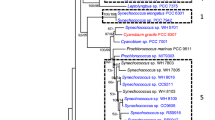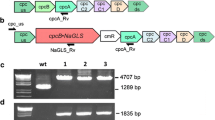Abstract
The eicosapentaenoic acid (EPA) synthesis gene cluster from an EPA-producing bacterium, Shewanella sp. SCRC-2738, was cloned into a broad-host range vector, pJRD215, and then introduced into a marine cyanobacterium, Synechococcus sp. NKBG15041c, by conjugation. The transconjugant cyanobacteria produced 3.7±0.2% (2.24±0.13 mg/L) EPA (n-3) and 2.5 ±0.2% (1.49±0.06 mg/L) eicosatetraenoic acid (n-3) of the total fatty acids when the cells were cultured at 23°C at a light intensity of 1,000–1,500 Lux. The EPA and eico-satetraenoic acid contents of the cells were increased to 4.6±0.6% (3.86±1.11 mg/L) and 4.7±0.3% (3.86±0.82 mg/L), and 7.5±0.3% (1.76±0.10 mg/L) and 5.1±0.2% (1.19±0.06 mg/L) when they were cultured at low temperature (18°C) and at lower light intensity (40 Lux), respectively.
Similar content being viewed by others
Abbreviations
- EPA:
-
eicosapentaenoic acid
- GLC:
-
gas-liquid chromatography
- GC-MS:
-
gas chromatography-mass spectrometry
- ORF:
-
open reading frame
- PUFA:
-
polyunsaturated fatty acid
- TLC:
-
thin-layer chromatography
References
Abbey, M., Clifton, P., Kestin, M., Belling, B., and Nestel, P. (1990) Effects of Fish Oil on Lipoproteins, Lecithin: Cholesterol Acyltransferase, and Lipid Transfer Protein Activity in Humans, Atherosclerosis 10, 85–94.
Simpoulos, A.P. (1999) Essential Fatty Acids in Health and Chronic Disease, Am. J. Nutr. 70, 560S-569S.
Watanabe, K., Sezaki, K., Yazawa, K., and Hino, A. (1992) Nutritive Fortification of the Rotifer Brachionus plicatilis with Eicosapentaenoic Acid-Producing Bacteria, Nippon Suisan Gakkaishi 58, 271–276.
Cohen, Z., Norman, H.A., and Heimer, Y.M. (1995) Microalgae as a Source of ω3 Fatty Acids, in Plant in Human Nutrition (Simopoulos, A.P., ed.) pp. 1–31, Karger, Basel.
Cohen, Z. (1990) The Production Potential of Eicosapentaenoic Acid and Arachidonic Acids by the Red Alga Porphyridium cruentum, J. Am. Oil Chem. Soc. 67, 916–920.
Yazawa, K., Araki, K., Watanabe, K., Ishikawa, C., Inoue, A., Kondo, K., Watabe, S., and Hashimoto, K. (1988) Eicosapentaenoic Acid Productivity of the Bacteria Isolated from Fish Intestine, Nippon Suisan Gakkaishi 54, 1835–1838.
Yazawa, K. (1996) Production of Eicosapentaenoic Acid from Marine Bacteria, Lipids 31, S297-S300.
Takeyama, H., Takeda, D., Yazawa, K., Yamada, A., and Matsunaga, T. (1997) Expression of the Eicosapentanoic Acid Synthesis Gene Cluster from Shewanella sp. in a Transgenic Marine Cyanobacterium, Synechococcus sp, Microbiology 143, 2725–2731.
Sode, K., Tatara, M., Burgess, J., and Matsunaga, T. (1992) Conjugative Gene Transfer in Marine Cyanobacteria: Synechococcus sp. and Pseudoanabaena sp., Appl. Microbiol. Biotechnol. 37, 369–373.
Simon, R., Priefer, U., and Puhler, A. (1983) A Broad Host Range Mobilization System for in vivo Genetic Engineering: Transposon Mutagenesis in Gram Negative Bacteria, Bio/Technology 118, 640–659.
Davison, J., Heusterspreute, M., Chevalier, N., Ha-Thi, V., and Brunel, F. (1987) Vectors with Restriction Site Banks. V. pJRD215, a Wide-Host-Range Cosmid Vector with Multiple Cloning Sites, Gene 51, 275–280.
Watanabe, K., Ishikawa, C., Yazawa, K., Kondo, K., and Kawaguchi, A. (1996) Fatty Acid and Lipid Composition of an Eicosapentaenoic Acid-Producing Marine Bacterium, J. Mar. Biotechnol. 4, 104–112.
Wada, H., Gombos, Z., and Murata, N. (1990) Enhancement of Chilling Tolerance of a Cyanobacterium by Genetic Manipulation of Fatty Acid Desaturation, Nature 347, 200–203.
Murata, N., and Wada, H. (1995) Acyl-Lipid Desaturases and Their Importance in the Tolerance and Acclimation to Cold of Cyanobacteria, Biochem. J. 308, 1–8.
Golden, S.S. (1994) Light-Responsive Gene Expression and the Biochemistry of the Photosystem II Reaction Center, in Advances in Photosynthesis: The Molecular Biology of Cyanobacteria (Bryant, D.A., ed.) pp. 693–714, Kluwer Academic Publishers, Dordrecht.
Cohen, Z., Vonshak, A., and Richmond, A. (1988) Effect of Enviromental Conditions on Fatty Acid Composition of the Red Alga Porphyridium cruentum: Correlation to Growth Rate, J. Phycol. 24, 328–332.
Watanabe, K., Yazawa, K., Kondo, K., and Kawaguchi, A. (1997) Fatty Acid Synthesis of an Eicosapentaenoic Acid-Producing Bacterium: De novo Synthesis, Chain Elongation, and Desaturation Systems, J. Biochem. 122, 467–473.
Murata, N., and Nishida, I. (1987) Lipids of Blue-Green Algae (cyanobacteria), in The Biochemistry of Plants (Stumpf, P.K., ed.) Vol. 9, pp. 315–347, Academic Press, New York.
Takeyama, H., Burgess, J.G., Sudo, H., Sode, K., and Matsunaga, T. (1991) Salinity-Dependent Copy Number Increase of a Marine Cyanobacterial Endogenous Plasmid, FEMS Microbiol. Lett. 90, 95–98.
Author information
Authors and Affiliations
Corresponding author
About this article
Cite this article
Yu, R., Yamada, A., Watanabe, K. et al. Production of eicosapentaenoic acid by a recombinant marine cyanobacterium, Synechococcus sp.. Lipids 35, 1061–1064 (2000). https://doi.org/10.1007/s11745-000-0619-6
Received:
Revised:
Accepted:
Issue Date:
DOI: https://doi.org/10.1007/s11745-000-0619-6




